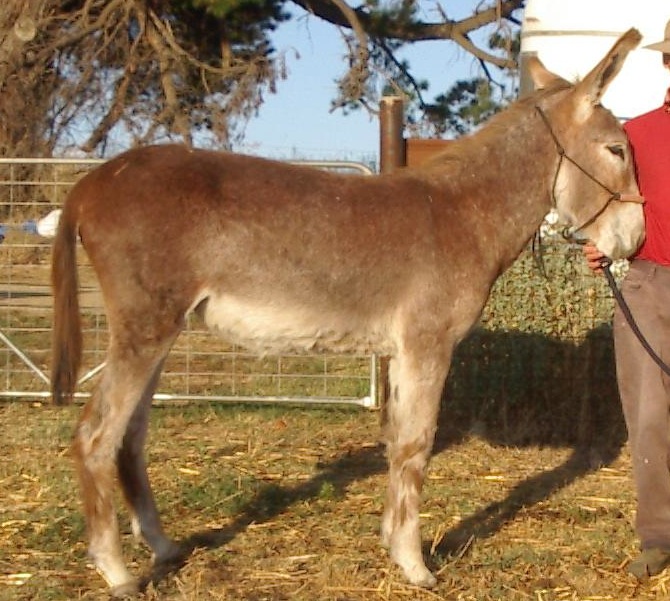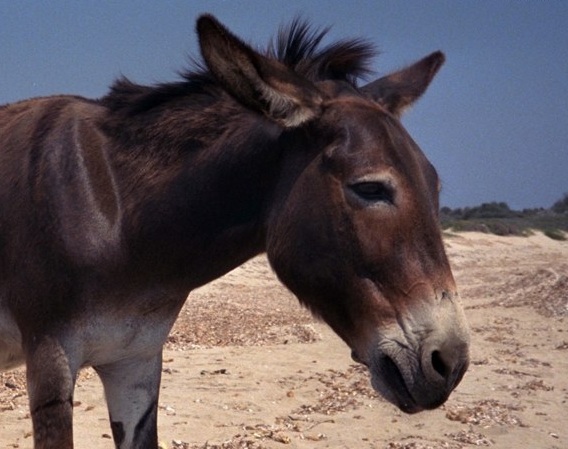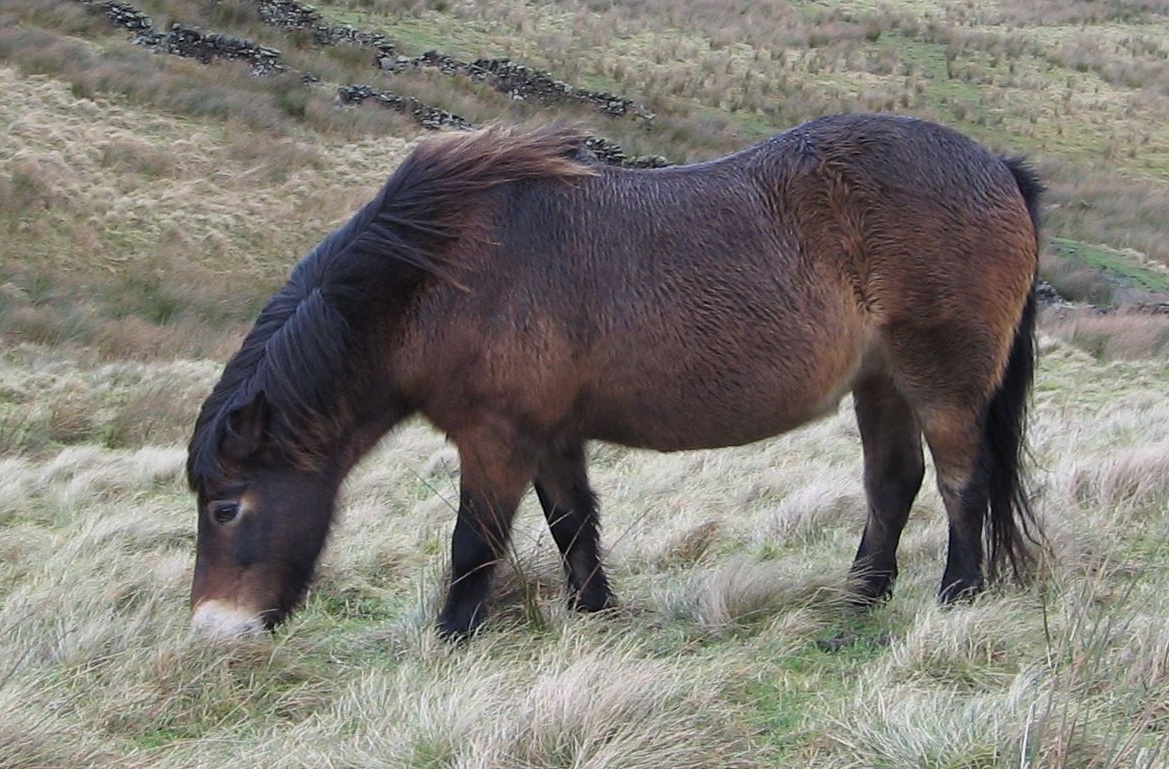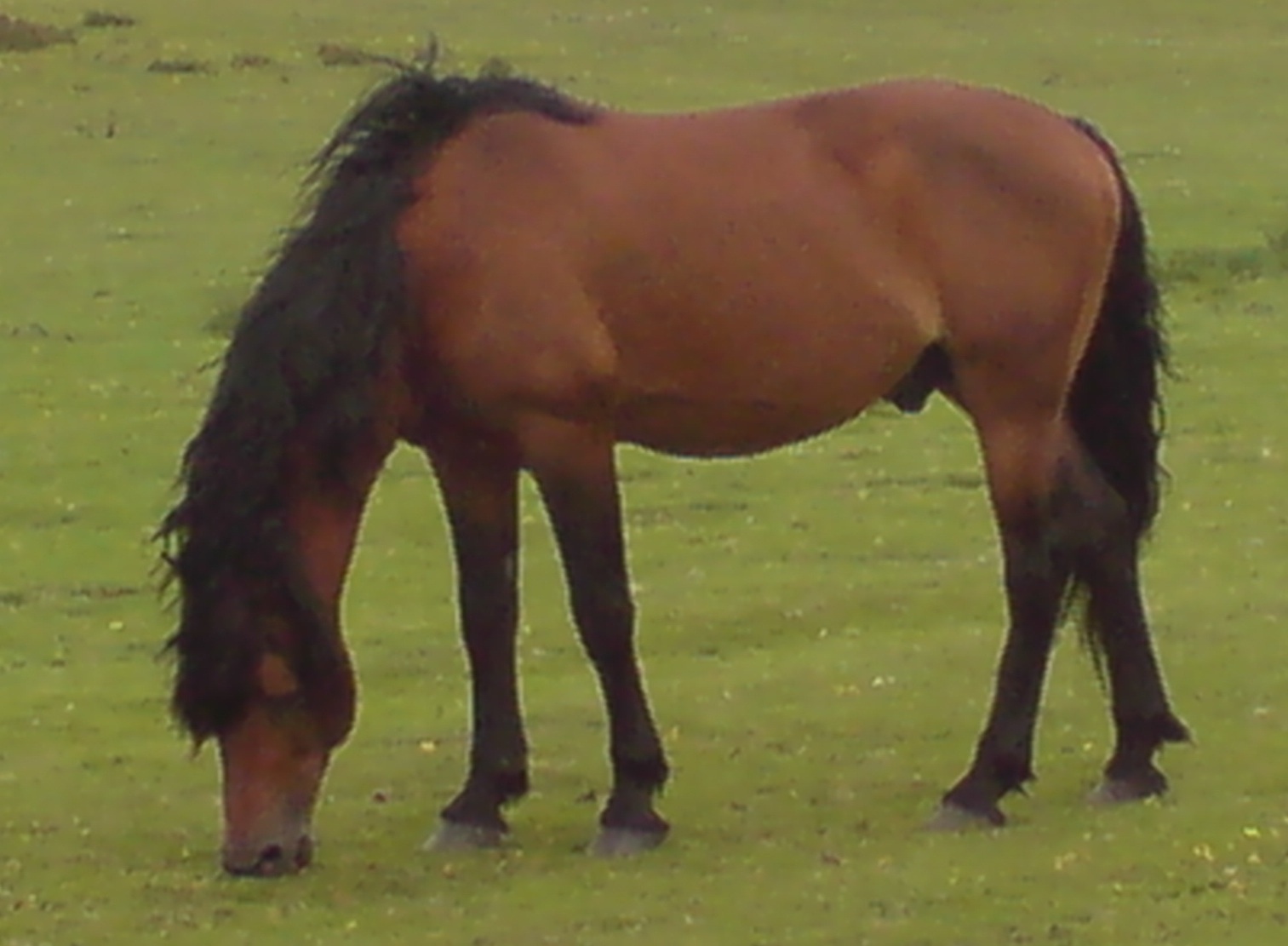A potted history of coat colour evolution in horses
Why colour, anyway?
Evolution works by natural selection - 'survival of the fittest'. In this context, 'fittest' doesn't necessarily mean size, strength, stamina or musculature. It simply means 'those which are most fitted to the local environment'. 'Fitted' means less likely to die out from a wide variety of death-inducing causes, including predation, and this particular cause of death is the most relevant when considering the evolution of coat colours in horses. Prey animals which are harder to see are harder to hunt, and therefore more likely to survive to breed and pass on their genes to the next generation. The longer they survive, the more offspring they can produce.
In horses and the related species, colour (until the interference of mankind) was all about camouflage, and certain colours and patterns have camouflage benefits over others in differing environments.
Ancient earth history
Most people are now familiar with the time-lapse photography of plants, giving the impression of flowers opening and shutting their petals in seconds, turning around to follow the sunlight, plants growing from seeds into trees in the space of (apparently) a minute or so, etc. Apply the same concept to a view of the earth as seen from space, and adjust the time-lapsing so that millions of years pass in a minute or so, and you would see whole continents whizzing about, colliding and separating; land bridges forming as water is turned into ice and sea levels fall, and disappearing as ice melts back into water and sea levels rise again; the gulf stream and other major ocean currents switching on and off and re-routing, affecting the climate (and thus the vegetation) across vast spans of the land surface, and so on.
At times, the ancient ancestors of our current range of species could move about pretty freely from one current continent to another; at times populations became isolated in areas with different climates and vegetations, and they constantly adapted to their conditions (over time) by the process of natural selection.
Horse history
The horse species originated some 55 million years ago in what is now the American continent, with a small animal known as Hyracotherium. To put this in a world-time scale, at the same time, much of "North America" was actually under shallow sea, Spain and Italy hadn't yet joined up with the rest of what was going to become Europe, and India was beginning to collide with the southern coast of Tibet, creating the Himalayas. Hyracotherium was older than Mount Everest.
From this root, a number of lines emerged, with differing characteristics. All but one of these lines died out, leaving a single successful branch, Dinohippus. (Dinohippus fossils are found in the Upper Miocene of North America and date from 13 - 5 million years ago.) All the modern horse species (including donkeys, asses and zebras, as well as horses and ponies) are almost certainly descended from Dinohippus, with the first Equus species appearing in what is now North America around 4 million years ago. There is huge variation in the number of chromosome pairs in the equine family, with the Hartmann's mountain zebra having only 16 pairs, the donkey species having 31 pairs, the domestic equines having 32 pairs, and the Przewalski's horse having 33 pairs.
For an easy-to-understand explanation of how DNA is structured, and how known DNA can be used to 'track down' unknown DNA, check out this link! Equine genome mapping work done by Elmer Ahrens of Switzerland suggests that the meta-centric horse chromosome ECA5 is represented by two chromosomes in E.przewalski, where ECA5p become EPR23 and ECA5q has become EPR24. However, four equine BAC [bacterial artificial chromosome] clones, two from each arm of ECA5 were used to investigate the relationship, with the BAC clones from the p arm hybridising as expected. In contrast, the BACs from the q arm (NF1A and IGLd) hybridised to ECA7 and EPR6. More work is being done on this ambiguity.
We don't know how many chromosome pairs Dinohippus had.
Colour history
Fossil records can't tell us what colour the early horse species actually were - that has to be a detective exercise. To assess the early colours, one has to look at the colours, markings and patterns shared by all the remaining horse species. The first thing one notices is that red-bay and chestnut donkeys are pretty much non-existent. I'm not going to say categorically that they don't exist, as there are certainly some pretty-red-bay appearing donkeys around the Mediterranean, and a few that seem to be genuinely chestnut, but in general terms you simply don't get them in the 'standard' population.
The picture of the almost-certainly-chestnut donkey shown to the right was kindly supplied by Pat Emmett of Southern Sky Mammoth Donkeys, Australia. It hasn't, so far, been genetically tested for the red gene.
Chestnut doesn't seem to appear at all in the zebra species, so the recessive e allele of the extension gene probably didn't occur in Dinohippus.

So basically, in the beginning there was the colour, and the colour was black (homozygous EE). All the Equus species have this gene.
The colour had some camouflage-necessary modifiers; specifically a version of dun, a version of agouti, and a version of pangare. Some forms of spot and stripe were almost certainly present as well. These are therefore 'ancient genes'. Look at a picture of a 'typical' donkey. He clearly shows the mealy patterns of the classic pangare gene, and he clearly shows a version of dun with a marked eel-stripe and shoulder stripes. Many donkeys also show barring on the legs. These patterns also appear in horses and ponies. 'Original / prehistoric dun' (probably very similar to donkey dun) developed variations later on, (donkey-dun in the donkey species and several minor variations on dun in the horse / pony species). It seems quite possible that the gene for the dun-striping patterns (primitive markings) is not actually the same gene as the one for the dun dilution, but simply placed very close to it on the chromosome (in domestic horses this is ECA8) and therefore unlikely to become separated from it during cross-over. There is some evidence that suggests that the stripe and dilution aspects of dun are separate; look closely at the seal-brown donkey in the next section. He has dorsal and shoulder stripes - but no dilution other than pangare. One can also get clearly line-backed and sometimes shoulder-striped (as opposed to counter-shaded) bay horses without dilution - the so-called 'disputed duns'.
The close relationship between dun and stripe can be seen by the transverse-dorsal vestigial stripes to be found on some dun horses, which closely mimic the lateral stripes on some zebras. Also, however, the leopard complex genes (found on ECA1 in the domestic horse) seem to be related to the zebra-striping pattern. A recent theory, supported by experiment, suggests that the striping patern of zebras is an effective means of confusing the visual system of the blood-sucking tsetse fly, which - although not a 'predator' - is a parasite which can affect survival and therefore evolution.
In some leopard-spot horses one can easily 'join the dots' into clear stripes, and in a few, the dots are elongated and appear very much as a 'broken stripe'; and in the re-bred Quaggas, the reduction of stripe is clearly going through a 'disintegrating-into-spot' phase (see pictures to the right).
The broken-stripe leopard foal shown here also showed dun striping and dilution, and the 'quagga' also shows dun-type dilution - so the 'stripe / dun / leopard' relationship is not going to be easy to sort out.



Sorraia horse foals have their own distinctive dun / stripe patterning, and the foal coat often shows zebra striping over much of the upper half of the body. (The Sorraia type is pretty much a direct equivalent of the ancestor of all the Iberian / Spanish descended horses. The only true substantiated genetic link has been established with the Lusitano, which has a genotype that is closely enough related that it is thought to have been another Sorraia genotype when this primitive horse was distributed in greater numbers.) Nearly all the remaining Sorraia horses are descended from the original group of 7 mares and 4 stallions (hardly representative of the original gene pool!) preserved by Dr. d'Andrade in 1920. Recent mtDNA testing of American Mustangs of distinctly recognisable Sorraia type has shown a definite genetic relationiship, and it's notable that many of these, too, have the same 'variety' of dun. In terms of colour history, it's interesting to note that ancient texts describe the Iberian wild horse as dun, and Dr d'Andrade did not get any outcroppings of other colours from his small breeding herd. DNA analysis of the Sorraia does indicate a very close relationship to the Tarpan.
Looking at the currently available dun patterns, it seems obvious that there is more than one allele (variation) of the dun gene in the horse / pony species, and the reason for this is that current domesticated horses derived from a number of ancient prehistoric stocks (e.g. northern British / Scandinavian, mid-Eurasion / Steppe, east-Eurasian / Mongolian, Mediterranean / Iberian, etc.) each with their own version of 'dun'. A horse can have up to 9 different dun factor markings.
Agouti - one lump or two?
Update 2010! We were right - there are definitely two distinct forms of the agouti gene, one (A) producing bay, and the other (know known as At) producing the seal-brown colour. Only one lab (http://www.petdnaservicesaz.com) is currently offering a DNA test distinguishing between the two forms; we hope more labs will follow suit. I'm leaving the pre-confirmation information here, to show the thinking and evidence which led to developing a specific test.
There's a school of thought (to which I subscribe) which suggests that there are two active forms (alleles) of the basic agouti gene. The logic / detective work which supports this idea is clearly illustrated by the three pictures below, and the fact that 'red bay' pretty-much never appears in donkeys. It's also known that seal-brown horses tend to breed 'true', and that red bay horses tend to breed 'true'. Red bay is caused by a version of the agouti gene, acting on black. Seal-brown is caused by a version of the agouti gene, acting on black. The left-hand picture is of a seal-brown donkey, clearly showing seal and pangare (mealy markings). The centre picture is of a seal-brown Exmoor pony, also clearly showing seal colour and pangare markings. The similarity between the two - and the difference between both of them and the red-bay New Forest pony with no pangare in the right-hand picture - is clear.



The donkey / zebra species split off from the horse / pony species some time between two and four million years ago - and the seal agouti gene remained present in both species.
The most recent ice age ended around 10,000 years ago, and at about the same time the horse species became extinct in the Americas. The land bridges between the Americas and the other continents disappeared with the melting of the ice, and the bridge between Great Britain and mainland Europe disappeared about the same time. Mankind hadn't yet had much of an impact on the colour of the equine species - domestication only began around 5,000 years ago (although it's possible that mankind was instrumental in the extinction of equines from the Americas).
A small population of equines became isolated in the British Isles, to which the current Exmoor pony is likely to be the closest match. This strain, evolutionarily referred to as the Celtic pony, has been studied in fossilized remains of ponies found in Alaska. These pony remains share a unique jaw type with the Exmoor, which is the 'purest' of the British native pony breeds, and the most ancient. It's basically a pre-historic pony. The Dartmoor pony is more 'recent' in terms of its skeletal structure, but even as late as 1924 registration records show that, in terms of colour, the coat was black-based, with bays, browns and blacks predominating, though there were also one "tan brown", two greys, three "fawns" and one dun.
Arctic tundra and the enormous steppes of central Eurasia, due to the climate, are predominantly dun-coloured for much of the year - and so are the ponies which evolved there. Ice ages are characteristically pretty dry times - most of the water is tied up in permanent ice, and there's little rain or snow in the glacial and sub-glacial areas. However, the wet south-west corner of Britain is characterised by outcroppings of dark-coloured granite rock, and in terms of camouflage there it's better to look like a dark-coloured rock than a pale-coloured pony, which might well explain why the dun gene became much more rare in the isolated population of equines inhabiting south-western Britain from which the Exmoors descended. Don't forget that at this time Britain was well-populated with large predatory carnivores - big cats and wolves. Wolves only disappeared from Britain a few hundred years ago. Although it's true that the majority of pure carnivores see pretty much in monochrome, one must also mention at this point that Britain also had intelligent predatory humans with good colour vision - mankind's first use for equids was as a food source!
The end of the last ice age brought major changes in the plants and trees of Northern Eurasia. Cold-weather trees (conifers) retain their needles all year round, and once one gets into tropical areas, the vegetation doesn't change much for most of the year. However, right across northern Europe vast areas of deciduous forests appeared. Deciduous trees, together with the bracken which often accompanies them, turn very red for a substantial time in the autumn - right at the time of year when weanling foals are spending time further away from their dams, aren't yet savvy enough to outwit predators, and are going through the 'I'm invincible' stage (which they share with teenage humans). The forest remains substantially or partially 'red' - particularly at ground level - until well into the early spring. In such an environment, it would be a major evolutionary advantage to have a reddish coat. Bay and chestnut ponies virtually disappear amongst the red bracken and autumn leaves.
Looking at equid species and colours in our best-documented and most readily available ancient text (the Bible!), even in Old Testament times red horses were linked almost exclusively, directly or indirectly, to the Romans (and other invaders). The Four Horsemen of the Apocalypse (yes, I know it's New Testament but its based on Old Testament stuff!) rode horses, and War specifically rides a red horse.
Ancient cave paintings of horses show animals with pangare patterning, apparently bay-agouti and seal-agouti based duns, seal agouti animals, and even a rare golden animal. How much of this can be historically relied upon is unsure, as pigments used in the paints can change over the course of 10,000 to 20,000 years! However, the bay agouti gene was almost certainly around to a large extent on the Eurasian mainland, though not in Britain, during the latter part of, and after, the last ice age. It seems likely that the bay agouti variation may well have first appeared further to the east. Sadly, the current population of the (eastern Eurasian) Przewalski horse can tell us little about the colours of the original, as all the remaining Przewalski horses descend from only 14 wild-caught animals. The red-bay colour is definitely a warmer-climate colour than the seal colour, and does appear to show in the very rare Persian Zebra, the Asiatic Wild Ass, and the re-bred Quagga-types descending from the Burchell's (plains) Zebra.
All this being the case, it's likely that the red-bay agouti gene, together with the red (e) chestnut gene, both gained strength in mainland Northern Eurasia after the separation of the foundation stock for the seal-agouti Exmoor (and other British) ponies at the end of the last ice age. The western primitives (Exmoor, Sorraia and Tarpan) show more evidence for the seal agouti allele, and the eastern primitives (Przewalski, Asiatic Wild Ass, and Persian Zebra) for the bay agouti allele. So, the original Dinohippus form of the agouti gene was predominantly seal-brown, and the less predominant variation was red-bay. I call these seal agouti and bay agouti respectively. (When genetic testing can distinguish between the two forms, they will probably be designated by As and Ab, to avoid having to use both a 'br' and a 'b' superscript, which could be confusing.) Seal agouti is an ancient allele, and bay agouti is likely to be a more 'recent' allele. It makes sense.
Dinohippus was a woodland rather than a desert animal; the evolution of coat colours in the wild cat species shows a similar slant, with the Northern European forest cats showing brown tabby (seal) colouration, and the desert-bred drier area animals throwing up the red colour variations. Domestic cats, of course, stem from a number of ancient feline strains.
Weather camouflage
After the end of the last ice age, there was a marked increase in precipitation (rainfall and snowfall). Horse species were migrating downwards through northern Eurasia into southern Eurasia, but the dun gene, which had been such an advantage to the dry-climate ice-age animals, and probably somewhat of a disadvantage to the 'warmer wetter forest' animals, didn't move down with them, although the donkeys retained it. (This shows that it's likely that the donkey / ass / zebra species originated in the African area before the horse types migrated there, retaining their dun gene as it benefitted them equally in cold dry areas and in hot dry areas. In Biblical Old Testament times, the equid species which predominated in Africa and the Middle East was the ass / donkey variety, not the horse / pony variety. They were there first!) The pangare gene, too, seems to have been bred out of the ancestors of the modern desert horses (Caspians and Arabians and their descendants).
Up in the far north, snow and frost became a regular feature; the dun gene was extensively retained in the Scandinavian, Steppe and northern mountain horses. One of the purposes of camouflage is to break up the outline of an animal, and any gene mutation which had this effect was going to be successful. Any dilution gene which paled-out the coat was also likely to be beneficial, and the seasonal variations in the northern diluted coats - paler in the winter - are a clear indication that this was a weather-influenced change. The cream and roan genes would undoubtedly have made an appearance at about the same time, as 'paling' genes.
The greying gene is a little more interesting. Looking at the 'modern-day stronghold' of the grey gene, we find it predominantly in horses of Western European descent. The Spaniards (who have much to answer for in respect of spreading horses around the world!) probably introduced the greying gene into many areas, including Britain. Looking at the modern 'sub-primitive' breeds, the one that seems most noteworthy in terms of preponderance of the greying gene is the Camargue (marshland) horse, which is exclusively grey. The Camargue is an ancient breed which has existed in its native habitat for centuries, and may be descended from the extinct Soutré horse, whose bones (dating from around 17,000 years ago) have been found in south-eastern France. There is some (justifiable) speculation that Camargue horses may have been introduced to Spain and crossed with the native Sorraia-type to produce the modern-day Lusitanos and their relatives and descendants. The greying gene may well be a camouflage adaptation to marshlands; it's really not easy to see a grey, greying or white horse in amongst reflections of the clouds and sun on water! (Battleships are not painted red, for a very good reason!) Looking at the bird species (which come in a vast range of colours and habitats), the birds commonly associated with open and semi-open (marshland) water, such as swan, heron, egret, stork, pelican, seabirds (varieties A - Z), etc., predominantly come in the colour scheme of white-and-grey, and open / semi-open water is the only non-polar habitat which throws mainly these colours in birds.
Looking at the old records for registered colours of horses, logic suggests that the cream gene probably originated in or around Scandinavia. Registrations of Norwegian Fjord horses (which are 'sub-primitive' and also remain a pretty pure breed) show that, between 1857 and 1879 almost 50% of horses registered definitely had a cream gene dilution. Cream-gene Fjord horses became less fashionable as breeders concentrated on the golden dun type coat; by the early 1900's the proportion had dropped to around 20%, and in the decade leading up to Word War II the proportion had dropped to only around 10%. The oldest registrations show that a significant number of horses were registered as "Other / Unknown"; double-cream dilutions may well account for this classification as blue-eyed creams weren't popular and the colour never had an official registerable name! This theory gives us, in the oldest registrations, the surprisingly Mendelian ratios of approximately 25% 'no cream' animals, approximately 50% 'single cream' animals, and approximately 25% 'double cream' animals. This would give us, out of the total population, 75% showing as cream-dilute animals. Even at only the 50% guaranteed cream dilutions, this is by far the highest percentage of cream gene animals to be found in any relatively pure and old breed, and the very high preponderance of cream in this area strongly suggests that this is where it originated. As always, the oldest records and registrations offer the best clues to the originating point of genes.
The various kinds of dun seem to descend from different prehistoric strains of horse. Again, the evidence for this isn't now clear, but it seems likely that the agouti gene had all but disappeared from the Iberian area (corresponding approximately to the area of Spain), leaving the indigenous Iberian horse as predominantly a black-based, rather than seal- or bay-based, dun. The Sorraia horse - the closest modern match to this prehistoric type - is almost exclusively blue or mouse dun in colour (i.e. dun gene on a black or seal-agouti base coat). The re-bred Tarpan (or Konik) isn't as good an indicator, as the early breeding stock had been first crossed with Eastern European working horses (domesticated), were then outcrossed to the Asian Przewalski horse, the Icelandic horse, the Gotland horse, etc. and then 'selectively bred' for what the Heck brothers considered to be 'Tarpan type'. There's been so much human interference in the re-breeding of the Tarpan type that one can no longer say what the original colour genetics of the Tarpan were. However, the first description of the original Tarpan (Johann Friedrich Gmelin, 1774) does specify that it was 'mouse colour' with prominent black points (i.e. blue dun or mouse dun).
The broken-coat (white marking) genes - ideal for camouflage in areas where broken snow covers underlying vegetation and rock, and also in bog, marsh and riverine woodland, where tree cover is associated with light reflected from water - undoubtedly appeared in the cold-blooded northern European forest horses.
The silver gene, which frosts black-based manes and tails extensively, and bodies less extensively, made an appearance in the ancestors of the northern British ponies (and possibly also in the northern Scandinavian ponies). Current distribution of the gene in the 'older' breeds suggests it originated in Britain rather than Scandinavia, as the silver gene appears in Shetlands but not in the Norwegian Fjord Horse. The flaxen gene performed the same outline-breaking function for the chestnuts as the silver gene does for the black-based animals, and the dark dappled (sooty) and spotted (leopard) markings appeared in woodland animals as body-outline-breakers. The cave paintings at Pech-Merle (mid-Pyrennean France), which are approximately 16,000 years old, show spotted horses.




